After the nightmare of developing games for Google, Revenge of the Savage Planet rises from the ashes
"They kept trying to get us to pitch for the monstrous games they wanted."
It took longer to buy back the Journey to the Savage Planet IP and source code from Google than it did to sell Typhoon Studios to it. "Because Google's used to buying stuff, but they are not used to giving it back," Reid Schneider, co-founder and studio head of Racoon Logic, tells me on a visit to their Montréal office for a hands-off preview of Revenge of the Savage Planet, a sort-of sequel to Journey to the Savage Planet.
I'm anecdotally told by Schneider and other Racoon Logic employees that Google wasn't used to a lot of how game development worked. "The core of it is: don't work with companies whose primary business is not making games, if you would like to make games," Alex Hutchinson, Racoon Logic co-founder and creative director, summarises. "[Google] didn't like how game development tasted," Schneider later adds.
The reason why new studio Racoon Logic knows so much about working with Google is that it was co-founded by, and hired, many employees who worked at Typhoon Studios, the developers of Journey to the Savage Planet. "The first, last, and only game Google ever paid for internally," Hutchinson laughs, as he and Schneider explain Typhoon's troubled history with Google.
The short of it is, Typhoon Studios was founded in 2017 by a small team of former triple-A developers who had many years worth of experience working on mega franchises like Assassin's Creed, Far Cry, Watch Dogs, The Sims, and Batman: Arkham. Google acquired Typhoon in 2019 and placed it under their Stadia Games and Entertainment division. You can guess how that turned out, as Stadia announced its closure on 1st February 2021 - the day Journey to the Savage Planet released on Stadia. When the team should have been celebrating their new release, they were instead drinking together over Zoom.
"If you get made redundant the best thing you can have is support from co-workers," Schneider says, "but in a pandemic, everyone's stuck in their basement."
"It was pretty dark," Hutchinson says. "The most callous redundancies in games are the day you ship, you know… but that happening in a pandemic really was not fun." The situation did act as a sort of rallying cry, however, as Hutchinson explains that most people wanted to "go around again".
Racoon Logic is Typhoon Studios' 'go around again', and similarly, Revenge of the Savage Planet feels more like the team's attempt to revisit and refine their initial vision for Journey to the Savage Planet, rather than being a true sequel in the traditional sense. The most obvious change being the switch from first-person to third-person. The team knew this would cost a lot of money, and Hutchinson still sounds particularly attached to the first-person view, but in the end he agreed that the perspective swap made sense. "It's easier for platforming, it's easier for customisation, it's hopefully funnier to watch now that you can actually see more than your hands, and our animators didn't quit, because they said there's not so much you can do with two hands."
Another big change is the scope. There are four full planets to explore now, not just one (with a bonus fifth planet that wraps the story). From the jungles of Stellaris Prime, to the frozen wastes and volcanic regions of Zephy, all have their own unique ecosystems and creatures to scan and perform dubious science experiments on. There's also more gear and upgrades to help with your adventures, including a new Goo Gun that can produce effects like a slippery green slime to trap poor creatures with - but the goo can interact with other elements. Like, say, some carelessly placed fire from a friend in co-op. Maybe this will help you solve a puzzle, or maybe you'll all go down in a mess of flaming gloop.
"We wanted that sense of organic chaos," Hutchinson says. "So for me, when I was working on Far Cry, the moment that made me think of this was in an encounter throwing a Molotov cocktail, trying to kill an enemy, instead setting fire to a bear, and then the bear killing my friend. And that moment, if we can replicate that in 50 different ways, is a great experience."
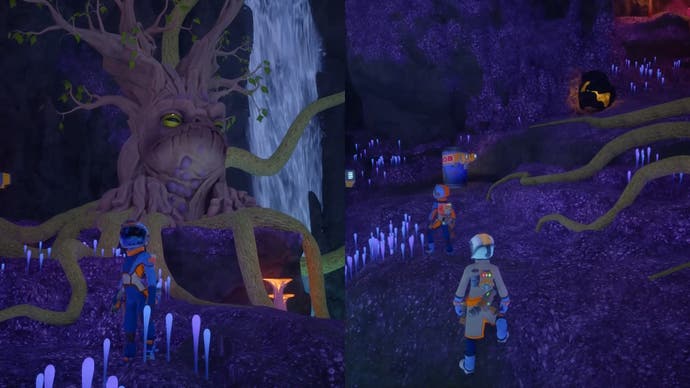

It's still just a two-player co-op experience, but now you can play together in split-screen couch co-op as well as online, including across platforms with crossplay. You even share your 'Crash Pad' customisable base with a friend when they drop into your world. This includes 'co-op toilets' that face each other. That's certainly some organic chaos right there.
Other new additions include underwater swimming, a remote controlled drone, character customisation, the much-requested ability to capture creatures, a map, and a versatile whip/lasso that can help with catching creatures, grappling, or turning into a tool for riding new Ratchet and Clank-like rails.
While I've only seen it in action for a short while, even with all of its new additions, Revenge of the Savage Planet still feels like the bright, silly, Metroidvania adventure seen in the original. Only this time we get to see it from a third-person point of view with charmingly over-exaggerated character animations, and can experiment with even more chaotic multiplayer scenarios. Without getting my hands on it, I can't tell if this makes for a better game yet. However, one thing that I can happily report is that the signature goofy humour Journey to the Savage Planet was known for is still intact.
Which takes us back to Google and Stadia, as there's a suspiciously familiar story being told in Revenge of the Savage Planet. The company you worked for in the first game, Kindred Aerospace (the fourth best interstellar company), has been acquired by a large multinational called Alta Interglobal, who have sent you on a mission into deep space. "But soon after sending you," Hutchinson explains, "Alta Interglobal realises that space exploration is difficult and expensive, so they decide to abandon all of that. So by the time you arrive on the planet, you've been made redundant."
"It's ripe opportunity for satire," Schneider says when explaining the gallows humour that emerged from the team's experiences with Google. The TV show Silicon Valley was also a big inspiration, as they wanted to do that sort of comedic style in a video game. "You're still the fourth best, but now you're the acquired fourth best."
"The pitch became the fourth best bought by the first worst," Hutchinson adds.
It's not just Google's poorly-timed layoffs that led to these kinds of sentiments within the team. As alluded to above, the tech company didn't seem to understand how game development worked at a most basic level, which led to Typhoon Studios working on the sequel to Journey to the Savage Planet "Much to [Google's] chagrin," Hutchinson reveals. "They kept trying to get us to pitch for the monstrous games that they wanted."
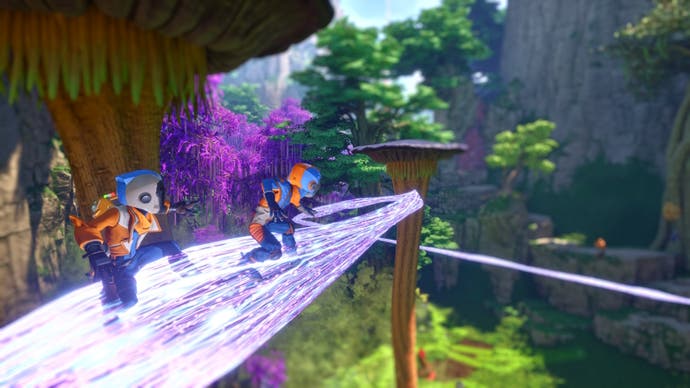
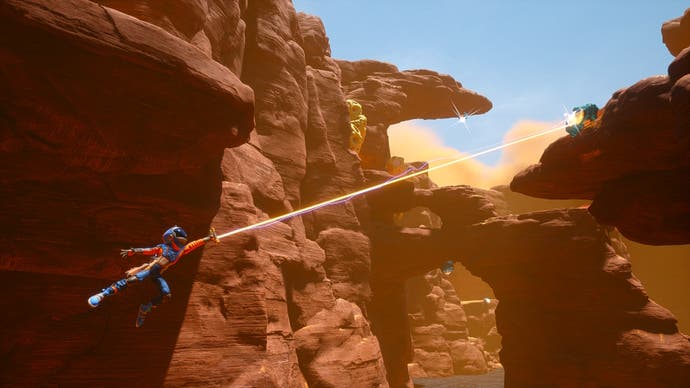
Marc-Antoine Lussie, Racoon Logic co-founder and Technical Design Director explains that one of Google's asks was for games that could only be possible on the Cloud.
"It was like saying 'here at Netflix, we only make TV shows that couldn't be on any other form of TV', and you're like, I don't know what that is," Hutchinson says with a laugh. "They were very strange."
Google also wanted the studio to pitch games for big licences like Marvel and Star Wars, which the team knew from past experiences working in triple-A game development would take hundreds of people to make. Google wanted them to work on these games with Typhoon's 25 employees, then hire more employees if the game was successful.
Another request was that they make a game that 100 percent of people liked.
"No one was talking the same language… it was very difficult," Hutchinson says.
"We would ask these questions, and we would get the confused puppy look," Schneider adds.
Was there anything the team took from this experience?
"Money," Hutchinson jokes.
Something Racoon Logic has taken from their days in triple-A development is the need to set sustainable, realistic goals to stop crunch. "We want people to be able to continue to make great games through the duration of the project, and not turn into zombies," Schneider says, "Because we all did it in the early 2000s and we don't want to go back to that."
The team also wants to stay away from the games as a service trend, especially now that they're making indie games. So even though there are things like cosmetic customisation and small future updates planned for Revenge of the Savage Planet, it's not something designed to keep you coming back forever. "When we were working in triple-A, everyone wanted 1000 hours of gameplay, and I started to find that the most terrifying thought of all time," Hutchinson says. "We want to make finishable, unique experiences that don't outstay their welcome, you know. To get back to those games that I grew up on, which were games that you could finish, put on a shelf and let go of. "
"We're definitely going to support the game post launch," Schneider clarifies when asked about a potential roadmap or DLC plans. It's all dependent on how the game does, but that support may take the form of things like different gameplay modes, a photo mode, and more cosmetic options. However, Schneider clarifies that this doesn't include things like micro-transactions.
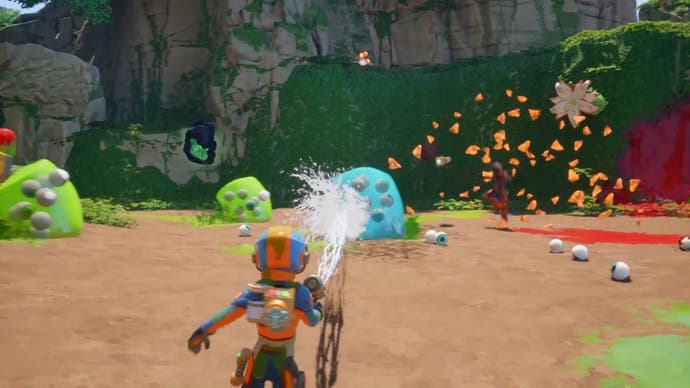

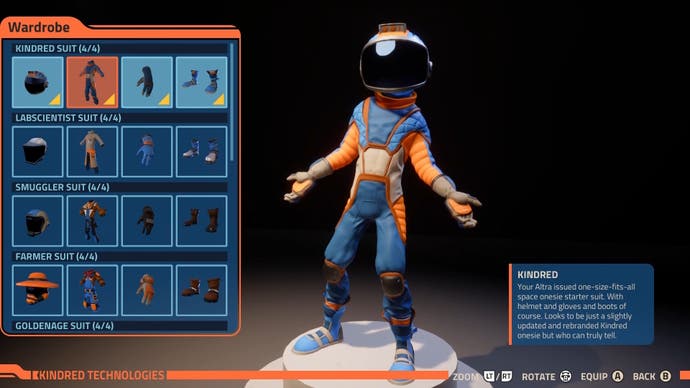
Monetisation aside, after my brief time with it, I can't help but feel like Revenge of the Savage Planet actually has a lot of potential to be the type of game that rewards repeat playthroughs. Maybe not 1000 hours of gameplay, but something you can drop in and out of with friends, with a different funny story to share each time. Was it a successful exploration into the swamp this time, or did you both get blown up? Did your friend kick you off a cliff for a laugh, or did you work together to set fire to those poor creatures with your Goo Guns? There's certainly a larger focus on the co-op experience this time, even though you can still play solo, and it's something I can see myself playing with both friends, and my younger nieces. Colourful and silly enough for everyone to get something out of, as long as it lives up to the promise of emergent shenanigans I saw during my time watching it being demoed.
"We wanted it to be bright and happy, optimistic and upbeat," Hutchinson says when describing their vision for the first game, and now its sequel. "Every time I watch an Xbox showcase, or I watch a PlayStation showcase, it's always so grey and brown and serious and kind of depressing."
"If you're going to make an indie studio, you've got to make stuff that sticks out," Schneider says.
Revenge of the Savage Planet is not something that can only be made on the cloud. It's not a Marvel or Star Wars game, and somehow, I don't think 100 percent of people will like it. However, I do think it stands out - it's got charm. Something sorely lacking in a lot of other games that try making their fortune in the multiplayer space these days. It's tough to tell right now without playing it for myself if this charm translates into a genuinely fun game, but at the very least, I'm looking forward to experimenting with the Goo Gun, fire, and my poor, unsuspecting co-op partner.
This preview is based on a press trip to Montréal. Racoon Logic provided flights and accommodation.


